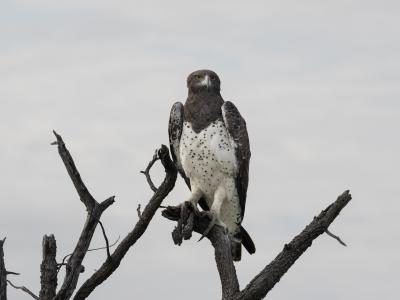Zambia
-
Nov 23 to Dec 7 2024
Ethan Kistler
South Luangwa Extension to Dec 11 -
Nov - Dec, 2026
Ethan Kistler
South Luangwa Extension
2026 Tour Price to be Determined
2026 Tour Price to be Determined
Zambia is an extremely scenic country in the middle of sub-Saharan Africa with numerous wonderful parks and safari areas. It is also unusually diverse biologically, and has one of the largest bird lists in Africa (even though under-birded), surpassing 750 species. Zambia is also a premier destination for mammals, and we hope to see plenty of antelope species and with that, large predators such as lions, leopards, and perhaps groups of African Wild Dogs. It’s a destination you don’t want to miss! We’ll begin near the renowned Victoria Falls, which stretches for a mile, drops 350 ft, and creates a mist forming a microclimate surrounding the falls with lush green forests full of birds. Moving to the interior of the country, we’ll visit mammal-rich Kafue National Park, which also hosts the localized Black-cheeked Lovebird. Nearby, the miombo woodlands around Choma hosts Zambia’s only true endemic: Chaplin’s Barbet. We’ll continue to the northeast and Kasanka National Park where we’ll spend three nights. The birding here is phenomenal and we’ll keep an eye out especially for Fulleborn’s Longclaw, and perhaps a Pel’s Fishing-Owl. There are plenty of mammals around as well including the Sitatunga and we should witness hundreds of thousands if not millions of Straw-colored Fruit Bat departing their colonial roosts.
Nearby, we’ll look for the highly localized Katanga Masked-Weaver before moving on to Mutinondo Wilderness Area, undoubtably the most scenic region of Zambia. Our accommodation is nestled among spectacular inselbergs and the area hosts a number of species easier here than nearby Kasanka as well as a few specials including Chestnut-headed Flufftail.
We’ll finish back on Zambia’s southern border along the Lower Zambezi River valley where we’ll target African Pitta which we expect to be displaying on territory.
Day 1: The tour begins in Livingstone. Depending on arrivals, we’ll bird the accommodation grounds located between town and Victoria Falls and overlooking a tributary of the splendid Zambezi River. We’ll keep an eye out for White-fronted Bee-eater, Pied Kingfisher, and African Jacana along the shorelines while in the gardens we may see White-fronted Robin-Chat, Collared Palm-Thrush or noisy groups of Arrow-marked Babblers. Night near Livingstone.
Day 2: We’ll have the full day to absorb mind boggling, mile-wide Victoria Falls and bird the surrounding area. Plunging 350 ft into the gorge below, the spray from the falls has created a lush rainforest around its border where we hope to see Schalow’s Turaco and Trumpeter Hornbill. Not far from the falls we may see Long-toed Lapwing, Lesser Jacana, Half-collared Kingfisher, Broad-tailed Paradise Whydah, Dusky Lark, Rock Pratincole, and African Finfoot. Night near Livingstone.
Day 3: We’ll depart early for the Nanzhila Plains at the southern edge of Kafue National Park. This area hosts the near-endemic Black-cheeked Lovebird, which regularly comes to drink at a local watering hole. We’ll also keep an eye out for Wattled Crane, Southern Ground Hornbill, Dickinson’s Kestrel, and perhaps a mix of vultures, many of which are endangered or critically endangered. Night at Nanzhila Plains.
Day 4: We’ll have all morning to explore the mopane woodlands and open plains around Nanzhila where we’ll be alert for Saddle-billed Stork, Verreaux’s Eagle-Owl, Bennett’s Woodpecker, Lilac-breasted Roller and Magpie Shrike to name a few. This area is also rich in mammals, and we may see a good selection of antelope such as Roan and Sable, and attendant predators including Wild Dog, Cheetah, and Lion. If we’re lucky, we may spot a Honey Badger or Serval. After lunch we’ll depart for Choma in the fig-tree savanna biome. Night in Choma.
Day 5: We’ll have the full day to bird the Nkanga Conservation Area, one of the most reliable sites for the endemic Chaplin’s Barbet. Other birds that will distract us include Black-chested Snake-Eagle, Green Woodhoopoe, Racket-tailed Roller, Miombo Tit, Stierling’s Wren-Warbler, and Arnot’s Chat. If there is water, we may find Lesser Moorhen, Allen’s Gallinule, and Parasitic Weaver. Night in Choma.
Day 6: A travel day: after breakfast we’ll head toward the capital and our lodging north of the city. If time permits, we’ll make a birding stop on the outskirts of Lusaka where miombo woodlands may reveal Souza’s Shrike, Pale-billed Hornbill, and Spotted Creeper. Night north of Lusaka.
Day 7: We’ll finish our drive to Kasanka National Park, our base for the next three nights. We’ll make a few stops along the way to stretch our legs and see some birds. If time permits, perhaps tonight, we’ll witness hundreds of thousands or millions of Straw-colored Fruit Bats leaving their colonies. The park is home to roughly ten million of these migratory bats. Night at Kasanka.
Days 8-9: We’ll have two full days to explore this varied park, home to over 110 species of mammals and an impressive list of birds possibly including Boehm’s Bee-eater, Pel’s Fishing-Owl, Purple-throated Cuckooshrike, Boehm’s Flycatcher, White-tailed Blue Flycatcher among many others. On the mammal front, the rare Lichtenstein’s Hartebeest has a good population here along with Sable, Puku, and Sharpe’s Grysbok.
On one of the days, we’ll detour to search for the highly localized Katanga Masked-Weaver which has a patchy distribution in northwest Zambia and southeast Democratic Republic of Congo. Nights at Kasanka.
Days 10-11: Today we’ll make the 4-hour drive to Mutinondo Wilderness Lodge, one of the most scenic regions of Zambia, for two nights. Nestled among the dramatic inselbergs, Bocage’s Akalat, Gray-olive Greenbul, White-tailed Blue Flycatcher, Anchieta’s Sunbird and Western Miombo Sunbirds are easier here than in Kasanka, while Eastern Miombo Sunbird, Bar-winged Weaver, Laura’s Woodland-Warbler, White-tailed Crested-Flycatcher, Marsh Widowbird, and Green-headed Sunbird would only be found here. We’ll spend extra effort on Chestnut-headed Flufftail, an incredibly rare and elusive bird. At the time of this writing, there are only a dozen records on eBird. Nights at Mutinondo Wilderness Lodge.
Day 12: We’ll spend the morning cleaning up species we may be missing before driving to Forest Inn, halfway back towards Lusaka. Although only an overnight to break to a long journey, the birding here is excellent and we’ll shope for Chestnut-backed Sparrow-Weaver and Black-necked Eremomela. Night at Forest Inn.
Day 13: Leaving the north behind, we’ll make the long drive south towards the Lower Zambezi where we’ll experience another unique woodland habitat dominated by open-canopied mopane trees and crossed by the occasional streams lined with riparian vegetation. Night near Chirundu.
Day 14: We’ll focus on the highly prized African Pitta. Having just returned to their breeding territory, they’ll be in full display making them easier to see. We’ll also search for other marvelous birds occurring in this new habitat, including Barred and African Emerald Cuckoos, African Broadbill, Livingstone’s Flycatcher, and Bearded Scrub-Robin. Night near Chirundu.
Day 15: We’ll have a second morning as a backup for African Pitta, and to clean up on any other species we may still be missing, before heading back to Lusaka where the trip concludes in time for evening departures.
South Luangwa Extension
Ext Day 1 (Day 15): Night in Lusaska.
Ext Day 2: This morning we’ll take a short 1-hour flight from Lusaka to Mfuwe and transfer to our comfortable accommodation situated right on the scenic Luangwa River. Here we may spot our first mammals, including elephants, hippos, Impala, and perhaps some lions. The lush property should be active with birds such as Jameson’s Firefinch, Sulphur-breasted Bushshrike, Tropical Boubou, Retz’s Helmetshrike, and perhaps our first Lilian’s Lovebirds. The river should provide a host of waterbirds including an excellent representation of storks, namely Yellow-billed, Saddle-billed, and Marabou. At night we may fall asleep to the sounds of hippos, distant hyenas and perhaps a Square-tailed Nightjar. Night in South Luangwa.
Ext Days 3-4: Covering an area over 5,600 sq miles, South Luangwa National Park has a reputation for being an unspoiled wilderness and is a renowned destination for mammal viewing. Among the large numbers of Impala and Puku, we’ll keep an eye out for African Buffalo, “Crawshay’s” Zebra, Blue Wildebeest, Giraffe, and a host of predators including African Lion, African Wild Dog, Spotted Hyena, and an impressive number of Leopards. Not only is the safari aspect unparalleled, but the birding is exceptional with over 400 species occurring in the park. One of our main targets will be Lilian’s Lovebird, which is unlikely to be seen on the main tour, but common in the park.
The river hosts an impressive array of birds such as flashy Southern Carmine Bee-eaters, which breed in colonies on the riverbanks, African Skimmers, various lapwings that prefer sandy islands, and perhaps large gatherings of Gray Crowned-Cranes. If we are particularly lucky, we may spot the elusive African Finfoot in the shadows of trees overhanging the water.
We’ll bird a variety of habitats including mopane woodlands and lush riverine woodlands along the Luangwa River where we’ll keep an eye out for Red-billed and Yellow-billed Oxpeckers on the plentiful game, the gorgeous Red-throated Twinspot, an excellent selection of hornbills and colorful starlings, and small flocks of finches coming in to pools of water including Southern Cordonbleus, Green-winged Pytilias, and Red-billed Firefinches. We’ll accumulate an impressive number of birds each day. Nights in South Luagnwa.
Ext Day 5: Depending on the flight, we may have some time to bird locally after breakfast before catching our flights back to Lusaka.
Note: The information presented here is an abbreviated version of our formal General Information for Tours to Zambia. Its purpose is solely to give readers a sense of what might be involved if they take this tour. Although we do our best to make sure that what follows here is completely accurate, it should not be used as a replacement for the formal document which will be sent to all tour registrants, and whose contents supersedes any information contained here.
ENTERING AND LEAVING ZAMBIA: British and American passport holders need a visa to enter Zambia. You can obtain a visa upon arrival, no payment involved. There is a US$25 departure tax leaving Zambia, which is usually included in airline ticket prices.
It is always a good idea to take a photocopy of your passport and air ticket with you when travelling abroad. They can prove invaluable in helping you get replacements if your originals are lost or stolen. Obviously, you should keep the photocopies in a separate bag to the originals.
COUNTRY INFORMATION: You can review the U.S. Department of State Country Specific Travel Information here: https://travel.state.gov/content/travel.html. Review foreign travel advice from the UK government here: https://www.gov.uk/foreign-travel-advice and travel advice and advisories from the Government of Canada here: https://travel.gc.ca/travelling/advisories.
HEALTH: The Centers for Disease Control and Prevention (CDC) strongly recommend a malaria preventative and suggest up-to-date inoculations against hepatitis A and B, typhoid, polio and yellow fever. It might also be worth checking that you are adequately protected against tetanus. As some of these inoculations cannot be given concurrently you should contact your doctor straight away and obtain his advice about when to start your treatment.
For malaria prevention, please talk to your doctor or public health or travel health clinic about which drug is best for you. The CDC currently recommends one of the following antimalarial drugs: mefloquine (Lariam®), doxycycline, or Malarone®. You can review the latest CDC advisories here.
Please note that all health information provided here is gleaned by WINGS from online resources devoted to traveler’s health. It is essential that you consult with your own physician for up-to-date professional advice.
CLIMATE: Expected to be warm throughout with some rain.
PACE OF TOUR AND DAILY ROUTINE: The first thing to realise about this tour is that in order to cover the full range of habitats there is a fair amount of driving involved and although a lot of time is spent in the vehicles to cover the large distances between localities, there will be ample exercise on the non-travel days, though this will be far from strenuous. There are some very early starts on this tour. These are usually because of the need to be on site at dawn or shortly after to take advantage of the early morning bird activity. On a number of days we will have packed breakfasts and lunches.
When we have had a particularly early start, we will try to have a break in the middle of the day, which is often a quiet period for birds anyway. On most days, apart from the days we do some owling, we will finish in good time to allow an hour or so for washing and changing before the checklist and evening meal. The tour is not a strenuous one, though there are some nice long walks, and anyone with a reasonable degree of fitness will be able to take part fully in the tour.
ACCOMMODATION: Hotels and lodges in Zambia vary from adequate to very good. We will spend some time in smaller camps where facilities may be limited. Food is excellent, plentiful and usually very European, although hot and spicy food is available at some centers. Some lodging may not have mosquito netting so it is a good idea to bring along your own net, just in case.
- Thorn Tree House and Tented Camp is located halfway between Livingstone town and Victoria Falls. It offers camping, tented chalets and cottages *. There is a cash bar and swimming pool. Limited Wi-Fi and power outlets in main area. The camp is frequently visited by Elephants and Hippo at night!
- Nanzhila Lake Camp is in a prime game viewing area of the Southern Kafue National Park, looking out over lake Itezhi-tezhi. There are 3 tented chalets with a large ensuite bathroom. And a family unit with 2 bedrooms sharing a bathroom *. All rooms have comfortable beds with mosquito nets and expansive covered veranda for midday game viewing. There is no Wi-Fi available, electricity is found in the main area (solar).
- Golden Pillow Lodge is a comfortable local guesthouse just out of Choma town. Rooms as basic with an ensuite bathroom. Restaurant serves Zambian meals and curries. No Wi-Fi offered. Power outlets in the rooms.
- Wasa Lodge lies in the centre of Kasanka National Park. The veranda has a great view of Lake Wasa. There are 5 ensuite chalets and 3 more basic ones*. There is limited Wi-Fi and electricity in main area. Cash bar available. Meals served main lodge. Guided game drives and activities available.
- Mutinondo Wilderness – Mayense Camp is a full catering lodge. Chalets are well-built, thatched buildings set on a rocky outcrop. The lodge has five chalets*, a self-service bar and dining facilities (set menu). Limited solar lighting. Wi-Fi and electricity for charging (solar) in main area. Each chalet has a solar and wood water heater.
- Gwabi River Lodge has chalets that are well furnished with comfortable beds and air conditioning. They are all en-suite with large walk-in showers. Power outlets in the rooms. Meals are served in the main area (menu), where there is Wi-Fi, a cash bar and a swimming Pool.
* Single rooms might not be available at Nanzhila, Wasa and Mutinondo depending on group size and make-up. At Thorn Tree single en-suite might not be available (some rooms have shared ablution).
WIFI: as described in Accommodations section.
DRESS: Informal throughout the tour.
TRANSPORT: Transportation will be by minibuses or 4x4 vehicles driven by the leaders. Bottled water will be provided in the vehicles.
LANGUAGE: English is widely spoken.
SMOKING: Smoking is prohibited in the vehicles or when the group is gathered for meals, checklists, etc. If you are sharing a room with a nonsmoker, please do not smoke in the room. If you smoke in the field, do so well away and downwind from the group. If any location where the group is gathered has a stricter policy than the WINGS policy, that stricter policy will prevail.
GENERAL INFORMATION AND CONDITIONS OF WINGS TOURS: Please take a moment to read the WINGS General Information and Conditions. This section contains important information about how we conduct tours, e.g., what is included in the tour price, refund and cancellation policies, pace of the tours, and other information that will help you prepare for the tour.
ADDITIONAL INFORMATION: A more complete General Information for Tours to Zambia will be sent to each registrant on receipt of their booking. Final information with instructions for meeting the group, hotel addresses, etc., will be mailed about three weeks before trip departure. Other news will be communicated as necessary. If you have any questions, please let us know.
**Single rooms may not be available at all camps/lodges (see Tour Information for more details).
This tour is limited to eight participants with two leaders.


























